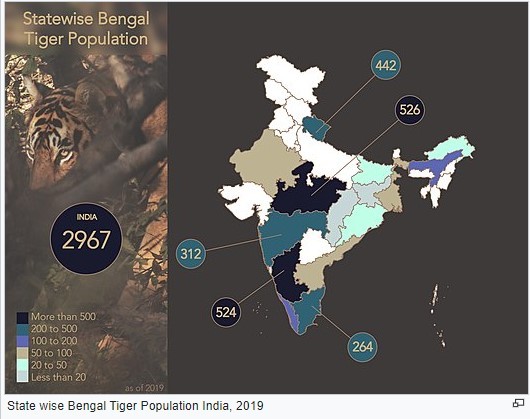Tiger Conservation in India and the World – All You Need to Know

A Report on Tiger census ahead of International Tiger Day on July 29 was released by the Environment Minister, Prakash Javadekar and as per the report the country “has 70 percent of world’s tiger population“. Since the beginning of the 20th century, the tiger population across the world dropped sharply and it is for the first time in conservation history, their numbers are on the rise. The increased number of big cats in India reflects equilibrium in nature as Tiger is an incredible part of it. The awe-inspiring tiger can be seen as one of the most iconic animals on Earth. Let’s look at a detailed analysis of Tiger conservation efforts of the world in general and India in particular in this context. 
This topic of “Tiger Conservation in India and the World – All You Need to Know” is important from the perspective of the UPSC IAS Examination, which falls under General Studies Portion.
What is the necessity to conserve Tiger as a species?
- Tigers are listed as “Endangered” on the International Union for the Conservation of Nature (IUCN) Red List of Threatened Species globally and the Malayan and Sumatran sub-species are listed as “Critically endangered.”
- The major reasons for the decline of tigers are poaching, Loss of natural habitat and prey depletion, Man-animal conflict, Diseases, Tourist Interference, Pollution and Climate Change.
- Tiger plays a pivotal role in the health and diversity of an ecosystem, a unique animal, and a top predator at the apex of the food chain and keeps the population of wild ungulates in check, thereby helping to keep a balance between prey herbivores and the vegetation upon which they feed. Therefore, the presence of tigers in the forest can be treated as an indicator of the well being of the ecosystem. The extinction of the tiger is an indication that its ecosystem is not sufficiently protected.
- Although Tigers had been hunted for at least a thousand years, it was estimated that 100,000 of them living in the wild. As the 20th century drew to a close there was a common fear that only 5,000-7,500 left in the world.
- Tigers had been given as a prize; their skins as a source of expensive coat till recently and were killed stating that they posed a threat to the human population.
- By the early 1970s tiger hunting was banned by most of the countries and trade in tiger skins was also barred.
- These efforts were properly awarded as Censuses of tigers in the 1980s showed their numbers to be increasing.
- These conservation efforts had been appeared successful and believed that there no longer was a threat of extinction.
- But, things were not as they expected. Tiger parts like skulls, bones, whiskers, sinews, and blood had long been used by Asian peoples, especially the Chinese, in medicines and potions used to treat rheumatism, rat bites, and various diseases and for various uses like in the restoration of energy and as aphrodisiacs. These body parts were never in short supply until tiger hunting was banned.
- In the late 1980s, however, there was serious evidence that tigers were still being killed began to accumulate. New tiger counts revealed that previous counts were having serious flaws and the previous censuses had been inflated by officials who either were in collusion with poachers or were merely eager to impress their superiors.
- At the same time, reports of poaching were multiplying, and as the dwindling supplies pushed prices ever higher, the underground trade in tiger parts
- Though there were a high number of seizures and destruction of such parts, but little effort was being put forth to stop the smugglers and the potions remained available in Chinese apothecaries in several nations.
- Severe pressure was put on governments to impose sanctions on countries that failed to take adequate measures to eliminate the trade in tiger parts.
- Conservationists urged Pres. Bill Clinton’sadministration to take action believing that only the threat of punitive measures by the U.S. would force any real change and in April 1994 USA barred the importation of wildlife products from Taiwan, valued at about $25 million annually. Some governments were attempting to cooperate.
- In March India convened the first meeting of the 10-nation Global Tiger Forum in an organized attempt to save the species. In India, where the largest number of tigers lived, as a need of the rapidly growing human population for more territory, both the habitat and food supply of tiger was robbing.
- Tiger estimation surveys have been conducting by the Wildlife Institute of India (WII) and the National Tiger Conservation Authority (NTCA), Government of India, in partnership with NGOs like WWF-India.
- The number of tigers in 2002 stood at 3,642 based on a census using the pug mark technique.
- The comprehensive country-wide tiger estimation exercise in 2010-11 conducted by WII, NTCA in partnership with WWF-India revealed a mean tiger population estimate of 1,706 which revealed the pathetic condition of tiger conservation in India.
- There were only 2,226 tigers left in the wild in India as per the 2014 tiger estimation exercise conducted by WII in association with the NTCA using camera traps.
What are the global initiatives for Tiger conservation?
Tiger conservation tries to check the animal from becoming extinct and protecting and preserving its natural habitat.
Convention on International Trade in Endangered Species of Wild Fauna and Flora (CITES)
- CITES has played an important role in improving international efforts for tiger conservation.
- CITES (also known as the Washington Convention) is a multilateral treaty to protect endangered plants and animals.
- CITES aims to ensure the international trade in specimens of wild animals and plants does not threaten the survival of the species in the wild, and it offers protection in varying degrees to more than 35,000 species of animals and plants.
- Tiger has been protected under Appendix I of the Convention on International Trade in Endangered Species of Wild Fauna and Flora (CITES) since 1975 which means commercial international trade in tiger is prohibited.
Global Tiger Recovery Program
- 13 tiger range countries adopted a Global Tiger Recovery Program at the Tiger Summit held in St Petersburg, Russia in November 2010.
- The aim is to double the number of wild Tigers by 2022 effectively through actions:
- Preserve, manage, enhance and protect habitats of tiger effectively;
- Eradicate poaching, smuggling and illegal trade of tigers, their parts and derivatives;
- Cooperate in Transboundary landscape management and in combating illegal trade;
- Engage with local and indigenous communities;
- Increase the effectiveness of Tiger habitat management;
- Restore tigers to their former range.
- Global Tiger Recovery Plan outlines how each country can contribute to the ambitious goal, called as TX2
Global Tiger Day
- It was observed for the first time in 2010 at the St. Petersburg Tiger Summit in Russia
- It is celebrated annually on July 29th.
What are the shortcomings of CITES?
- Though CITES has been successful in curbing the illegal trade, but as an international institution CITES relies on member states to effectively implement conventions within their national borders. The implementation quality depends and varies significantly within member states. For example, Even though Thailand implemented CITES policies to a very high standard but the illegal tiger trade is still on a rise within the country. CITES as a governance structure is powerless to control issues such as poaching unless it has the full cooperation of all actors, including the state.
- Another reason why CITES seems to be failing could be a moneymaking and the profitable nature of tiger trade. As per World Bank estimates that the illegal international trade of wildlife on the black market is worth $10bn per year. For example, a poacher could make an amount equal to what some laborer would earn in 10 years by selling one tiger skeleton.
Tiger conservation efforts in India
- At the beginning of the 20th century, one estimate of the tiger population in India placed the figure at 40,000.
- Serious concern was raised about the threat to several wildlife species and the reduction of wilderness in India from poaching at the IUCN General Assembly meeting in Delhi in 1969.
- A national ban on tiger hunting was imposed in 1970, and the Wildlife Protection Act came into force in 1972 and this act was set to formulate a project for tiger conservation with an ecological approach.
- Indian tiger census conducted in 1972 exposed the existence of only 1827 tigers.
- Project Tiger is a major effort to conserve the tiger and its habitats in India started in 1973.
Project Tiger; Management, criticisms and controversies
- Project tiger is a tiger conservation program launched by the Government of India in April 1973.
- Bengal Tiger is the national animal of India; this project aims to reduce the diminishing population of the big cats and work to increase their numbers.
- The main objectives of this project are to ensure a viable population of tigers in their natural habitats for economic, scientific, cultural, aesthetic, and ecological values, protecting them from extinction, and preserving areas of biological importance as a natural heritage forever. Reduce factors that lead to the depletion of tiger habitats and to mitigate them by suitable management. The damages done to the habitat shall be rectified so to facilitate the recovery of the ecosystem to the maximum possible extent.
- Project Tiger is an ongoing Centrally Sponsored Scheme of the MOEFCC providing central assistance to the tiger States for tiger conservation in designated tiger reserves
- In order to assist patrol and protection of tiger habitats, the monitoring system M-STrIPES (Monitoring System for Tigers – Intensive Protection and Ecological Status) was developed which can map patrol routes and allows forest guards to enter sightings, events and changes when patrolling. Based on these data, it generates protocols, so that management decisions can be adapted.
- The administration of project Tiger was carried out by the National Tiger Conservation Authority and is monitored by a steering committee.
- Based on the ‘core-buffer’ strategy various tiger reserves were created in the country:
- Core area: free of all human activities, has a legal status of a national park or wildlife sanctuary, and kept free of various biotic disturbances and forestry operations like minor forest produce collection, grazing, and other human disturbances are not allowed within.
- Buffer areas: subjected to ‘conservation-oriented land use’, comprise forest and non-forest land and is a multi-purpose use area with two major objectives
- Providing habitat to spillover population of wild animals from core
- To provide site-specific co-developmental inputs to surrounding villages relieving their impact on core area.
- Project Tiger’s efforts were mainly hampered by poaching, also by the debacles and irregularities in Sariska and Namdapha.
- The Forest Rights Act passed by the Indian government in 2006 recognizes the rights of some forest-dwelling communities in forest areas which have led to controversy over implications of such recognition for tiger conservation.
- Some have argued that this is problematic as it will increase conflict and opportunities for poaching and some also assert that “tigers and humans cannot co-exist”.
- This can be treated as a limited perspective according to some and which overlooks the reality of human-tiger coexistence and the role of abuse of power by authorities in the name of tiger crisis, rather than local people, which was supported by the Government of India’s Tiger Task Force, and is also taken by some forest dwellers’ organizations.
Report of All India Tiger estimation 2020
- Every four years the tiger count is prepared by the National Tiger Conservation Authority (NTCA) provides details on the number of tigers in the 18 tiger reign states with 50 tiger reserves.
- This time as an exception the census also included data collected from the rough terrains of north-eastern states which were not possible earlier due to logistic constraints.
- This is considered to be the world’s largest wildlife survey effort in terms of coverage, the intensity of sampling and the entire exercise spanned over four years which sets Guinness World Record for being the world’s largest camera trap wildlife survey.
- To capture the movement of tigers Over 15, 000 cameras were installed at various strategic points and were supported by extensive data collected by field personnel and satellite mapping.
- Details of the report
- As per the report, India has 70% of the world’s tigers.
- According to the report, Madhya Pradesh has the highest number of tigers at 526, followed by Karnataka (524) and Uttarakhand (442).
- Mizoram and Chhattisgarh have a decline in the tiger population and all other States saw a “positive” increase, according to a press statement.
- Implementing CATS frameworks
- India had embarked upon assessing management interventions through the globally developed Conservation Assured | Tiger Standards (CA|TS) framework.
- This framework will now be extended to all fifty tiger reserves across the country.
Recent steps taken by the government:
- The Ministry has worked on a program to provide water and fodder to animals at the forest itself.
- For the first time, Lidar-based survey technology is being used to deal with the challenge of human-animal conflict that was causing the death of animals. Lidar is a method of measuring distance by illuminating the target with laser light and measuring the reflection with a sensor.
- To deal with emergencies arising due to the following, The National Tiger Conservation Authority has authorised official training.
- Tigers straying into human-dominated landscapes,
- Tiger depredation on livestock
- To work towards the rehabilitation of tigers.
- The major changes are made in the policy and management of tiger populations in order to fully implement provisions of the Wildlife (Protection) Act 1972 like
- Tiger landscape conservation plans
- Designation and notification of inviolate critical core and buffer areas of tiger reserves
- To Identify and declare the new tiger reserves
- Recognition of tiger landscapes and the importance of the corridors and their physical delineation at the highest levels of governance
- Integrating tiger conservation with developmental activities using the power of reliable information in a Geographic Information System database.
Conclusion
The efforts of the government to conserve tigers have been quite successful, where the number was around 1800 tigers in 1972 which reached about 3000 in 2018. Undoubtedly, these efforts will help in increasing the number of tigers in India and preserving biodiversity as Tigers are at the top of the food chain and are referred to as “umbrella species” sometimes because their conservation also conserves many other species in the same area.
Mains practice questions
- Examine the importance of conserving Tiger in the context of recent all India Tiger Estimation Report 2020. (250 Words)
- What is Project Tiger? Discuss the challenges associated with the conservation of Tiger. (250 words)




